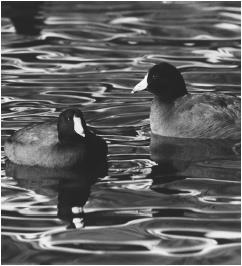|
This section contains 633 words (approx. 3 pages at 300 words per page) |

|
One of a dwindling number of freshwater marshes in California's San Joaquin Valley, Kesterson National Wildlife Refuge achieved national notoriety in 1983 when refuge managers discovered that agricultural runoff was poisoning the area's birds. Among other elements and agricultural chemicals reaching toxic concentrations in the wetlands, the naturally occurring element selenium was identified as the cause of falling fertility and severe birth defects in the refuge's breeding populations of stilts, grebes, shovellers, coots, and other aquatic birds. Selenium, lead, boron, chromium, molybdenum, and numerous other contaminants were accumulating in refuge waters because the refuge had become an evaporation pond for tainted water draining from the region's fields.
 Breeding populations of American coots were affected by selenium poisoning at Kesterson National Wildlife Refuge. (Photograph by Leonard Lee Rue III. Visuals Unlimited. Reproduced by permission.)
Breeding populations of American coots were affected by selenium poisoning at Kesterson National Wildlife Refuge. (Photograph by Leonard Lee Rue III. Visuals Unlimited. Reproduced by permission.)
The soils of the arid San Joaquin valley are the...
|
This section contains 633 words (approx. 3 pages at 300 words per page) |

|


